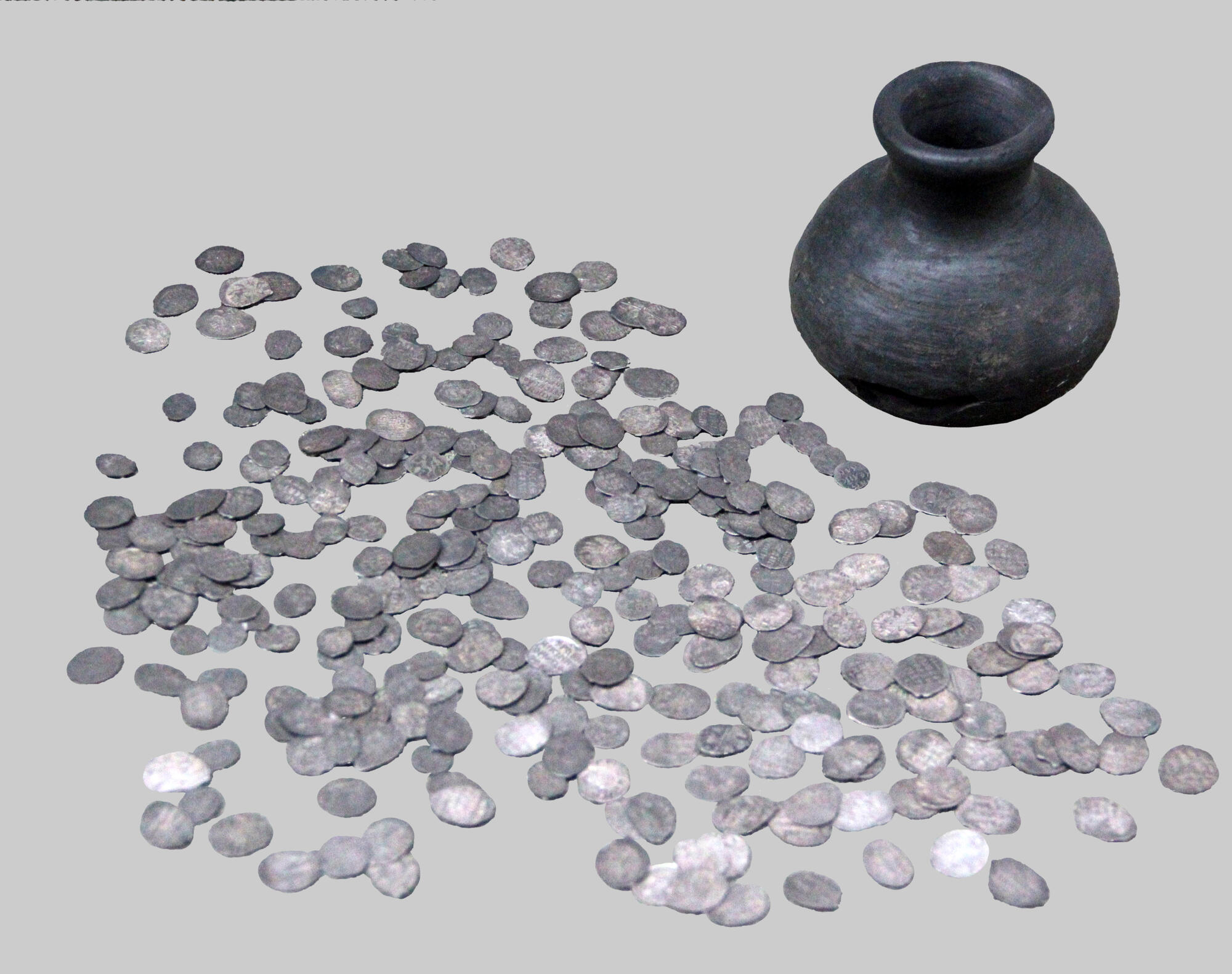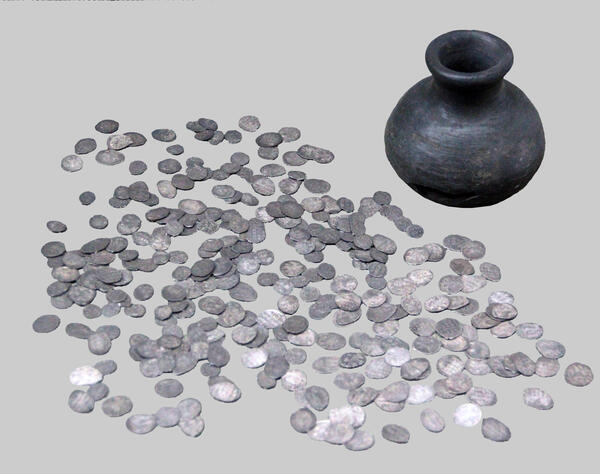Over the course of its centuries-old history, Velikiye Luki was often destroyed, both during the conflicts among sovereigns and during the raids of foreign invaders. The inhabitants would temporarily leave the city, often in a hurry. They hid their savings (treasures) and hoped to return, but this did not always happen.
The treasure kept in the museum is coins from the times of Ivan the Terrible and the Time of Troubles. It was found by LarIsa BeloUs, a resident of VelIkiye LUki, in 1992 while working on the plot at her summer cottage. She found a small clay box. The neck was covered with a small piece of cloth, which decayed over time and crumbled when the box was opened. Inside were 1,181 cheshUykas (scales), a silver coin of the late 16th - early 17th centuries. In the same year, the find was transferred to the Velikiye Luki Museum of HIstory and Local Lore.
Cheshuyki are coins that made their appearance in ancient Russia. The minting of cheshuykas stopped at the time of Peter I: he implemented a monetary reform, as a result of which the existing coins were replaced by larger ones.
The cheshuykas got their name due to their shape, which resembled fish scales. They had no face value: they were put in a bag and used to pay by weight. The exchange rate of gold in relation to silver was different then, so the value of silver cheshuykas was not much different from gold coins. The coins were weighed on scales and used to pay for goods. Although silver scales were made from a piece of wire, they were widespread. The use of wire as a material explains the unusual shape of the coins.
The coins had another distinguishing feature: it was difficult to say exactly what was depicted on the metal.
The treasure kept in the museum is coins from the times of Ivan the Terrible and the Time of Troubles. It was found by LarIsa BeloUs, a resident of VelIkiye LUki, in 1992 while working on the plot at her summer cottage. She found a small clay box. The neck was covered with a small piece of cloth, which decayed over time and crumbled when the box was opened. Inside were 1,181 cheshUykas (scales), a silver coin of the late 16th - early 17th centuries. In the same year, the find was transferred to the Velikiye Luki Museum of HIstory and Local Lore.
Cheshuyki are coins that made their appearance in ancient Russia. The minting of cheshuykas stopped at the time of Peter I: he implemented a monetary reform, as a result of which the existing coins were replaced by larger ones.
The cheshuykas got their name due to their shape, which resembled fish scales. They had no face value: they were put in a bag and used to pay by weight. The exchange rate of gold in relation to silver was different then, so the value of silver cheshuykas was not much different from gold coins. The coins were weighed on scales and used to pay for goods. Although silver scales were made from a piece of wire, they were widespread. The use of wire as a material explains the unusual shape of the coins.
The coins had another distinguishing feature: it was difficult to say exactly what was depicted on the metal.
There was not enough room for the stamp on the piece of wire, so the image on the cheshuykas was incomplete. It was possible to figure it out only by comparing several coins. For the same reason, it is impossible to find two identical cheshuykas.
In the past, hiding money in the ground or in a hiding place was as common as keeping it in a bank or safe in our time. Ordinary people thought it wise to find a safe and secure place for the treasure, away from prying eyes. Potters also reckoned with this custom: miniature pots and jugs for the modest treasures of poor people appeared very early in the assortment of their products.
The builders of stone buildings made numerous niches in the walls, which could be used as hiding places.
In the past, hiding money in the ground or in a hiding place was as common as keeping it in a bank or safe in our time. Ordinary people thought it wise to find a safe and secure place for the treasure, away from prying eyes. Potters also reckoned with this custom: miniature pots and jugs for the modest treasures of poor people appeared very early in the assortment of their products.
The builders of stone buildings made numerous niches in the walls, which could be used as hiding places.
Various other hiding places were used as well: people would hide the boxes in the oven, wall them up in the stone walls of churches and fortresses, lower them into wells and springs, carry them away from their homes into the forest and hide them in the hollow of a tree. But the ground was the best place to hide money.
Foreigners who visited Russia in the 17th century wrote in their notes a Russian custom which they found surprising: keeping money in the ground. The treasures were hidden temporarily. They were hiding them from people: the invading enemy, bosses, criminals, from the strangers' eyes, family members and servants. So, about the overwhelming majority of treasures we can say that, being hidden by human will, they have come to us clearly against this will.
Foreigners who visited Russia in the 17th century wrote in their notes a Russian custom which they found surprising: keeping money in the ground. The treasures were hidden temporarily. They were hiding them from people: the invading enemy, bosses, criminals, from the strangers' eyes, family members and servants. So, about the overwhelming majority of treasures we can say that, being hidden by human will, they have come to us clearly against this will.



